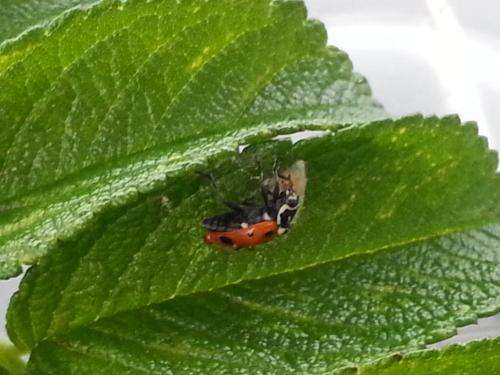February 11, 2015 report
Study shows example of a parasite using a bioweapon to control host

(Phys.org)—Researchers affiliated with several institutions in France have found that a species of parasitic wasp uses a virus as a bioweapon to stun a host ladybug into serving as a guard for its offspring. In their paper published in Proceedings of the Royal Society B, the researchers describe several techniques they used to uncover the true nature of the relationship between the wasps and lady bugs.
Nature is rife with examples of parasites causing behavioral changes in their hosts that benefit the parasite—tapeworms that cause their crustacean hosts to swim slower or faster, for example, to discourage or encourage predatory fish. In this new study, the researchers looked at the wasp, Dinocampus coccinellae and the ladybug, Coleomegilla maculate. Prior research has shown that the wasp lays its eggs inside the ladybug—and then somehow causes the ladybug to stand guard over the larvae after they leave the host's body and later pupate. How they made that happen has been a topic of conjecture.
To find out for sure, the researchers used transmission electron microscopy to study the eggs after they had been implanted in a ladybug. In addition to the eggs, the researchers found a virus, which they named D. coccinellae Paralysis Virus (DcPV). Additional research using RNA sequencing, and quantitative PCR showed that the virus was neural and infected the host ladybug, causing it to become nearly paralyzed (it could still move enough to ward off predators that might eat the pupae). The wasp had used a virus to force a ladybug to behave in a way that benefitted the wasp offspring—a form of bioweapon. Indeed it had harbored the virus in its ovaries which was transferred to the host along with the eggs. By the time the larvae were ready to pupate, the ladybug was already too impacted by the virus to do anything but stand still, serving as a guard.
In addition to serving as a guard, the ladybug also serves as a food source for larvae before they leave the ladybug's body and pupate, though the team found, neither the feeding nor the virus were always fatal for the ladybug—in roughly 25 percent of cases, the ladybug survived and went on to live a normal life.
More information: Who is the Puppet Master? Replication of a Parasitic Wasp-associated Virus Correlates with Host Behavior Manipulation, Proceedings of the Royal Society B, rspb.royalsocietypublishing.or … .1098/rspb.2014.2773
Journal information: Proceedings of the Royal Society B
© 2015 Phys.org



















